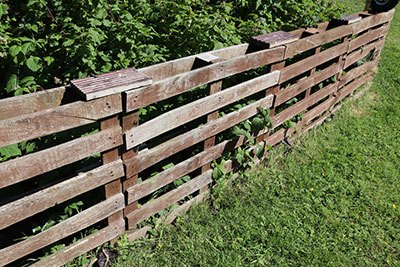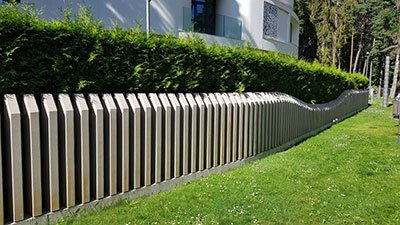Do you have a property that needs to be fenced off but you don’t have the time or resources to dig a hole? Building a fence may seem like an intimidating task.
Luckily, there are ways of building a secure and attractive fence without needing to spend hours in dirt and mud!
We’ll discuss what options are available for different kinds of fences, as well as tips and tricks for making sure your new fence will last.
So keep reading if you want to put up a barrier without all the hassle of breaking out the post-hole digger!
Take away key points:
- The no-dig fence works well on rough terrain, and tough ground, and adds a better idea to your house
- You don’t need concrete footings, wood posts, ad similar parts to make protect your yard
- Find the best fencing below in our installation settings
Table of Contents
If you need to build a fence, you might be wondering if you can finish the process without diggings the holes. So refer to our guide below, as we will help you with the progress.
Can you construct a fence without digging holes?
Many people are looking for ways to set up a fence without having to dig holes. Fortunately, there are several options available that can help you achieve this goal.
One of the most popular methods is using post anchors. Post anchors are metal plates that attach to the ground and provide support for the fence posts. You can construct a freestanding fence easier for secure fence panels.
Other fence posts use pre-made panels or sections of fencing. These come in various sizes and styles and can be easily installed without post holders. They also offer more stability than post anchors as they are secured directly into the ground with concrete, cement, or other materials.
Some types of fencing can be installed by simply attaching them to existing structures such as trees or walls. This method does not require any digging at all, but it may not be suitable for all types of fences depending on the size and weight of the material being used.

Why are people building fences without digging fence posts?
People are building fences without drilling for posts because it is a much easier and faster process than traditional fencing. It also eliminates the need for digging, which can be time-consuming and difficult in adverse soil conditions, such as rocky terrain, or rocky soil.
How to set a fence post without digging?
There are multiple methods to set a fence post installation without digging. Some of the most popular installing processes include:
– metal spike anchor and a sledgehammer
– T-post driver
– E-Z Spike
– Steel posts in the ground
– Above the ground fence post without digging
– jack fence
– snake-rail fence
– pallet fence
– buck fence
We will explain each of these fence posts separately.
1. Metal spike anchor and a sledgehammer
Setting a fence post without digging post holes can be done with the help of a metal spike anchor and a sledgehammer.
– drive the metal spike into the ground as far as possible by hand.
– slot a driving block into the top of the fence spike and hit it with a sledgehammer or heavy hammer. This will cause the anchor to rotate and cut a precise thread in the ground.
– place your post in the anchor and adjust it using a level tool to make sure it is even.
2. T-post driver (fence post driver)
If you need to install a fence post without digging, a T-post driver is the perfect tool for the job. A T-post driver is a heavy-duty tool that uses force to pound posts into the ground. It is simple and easy to use and can save you time and energy when installing fence posts.
– make sure that your post is properly aligned with the ground.
– hold the handle of the driver firmly against the post and begin pounding it into the ground.
– keep your arms straight as you pound so that you don’t strain yourself. Continue pounding until the post is securely in place.
When using a T-post driver, always wear protective gear such as gloves and safety goggles to protect yourself from any flying debris or splinters from the wood fence post. Additionally, check your local regulations regarding fence installation.
3. E-Z Spike

Installing an E-Z Spike fence post is a great way to secure a 4×4 post without the need for digging or pouring concrete. You can install the fence post easily:
– determine the location of your post. Make sure you have enough space around it for installation and that it’s in an area where it won’t be disturbed.
– place the E-Z Spike on top of the marked spot. This post-base spike will hold your 4×4 post securely in place. It has pre-drilled holes that make attaching the post easy and efficient.
– attach your 4×4 post to it using screws or nails.
– use screws that are long enough to go through both the E-Z Spike and your 4×4 post for maximum stability.
– use soil or gravel to fill in any gaps around the base of your 4×4 post and E-Z Spike combination. This will help keep everything secure and prevent movement over time due to wind or other forces.
4. Steel posts in the ground
Steel posts are an essential component of any fence, providing support and stability. Set a fence post by following this example:
– Select the right type of steel post for your fence. Steel posts come in a variety of shapes and sizes, including square, round, c-post, and postmasters (flange style).
– Consider factors such as the type of fence you’re installing and the environment it will be exposed to when choosing a first post.
– Use a manual or pneumatic post-pounder. This tool allows you to drive the posts into the ground without having to dig or use concrete.
– Ensure your steel posts are properly secured in place. If you’re using a manual or pneumatic post pounder, ensure that each post is driven at least 20-24 inches into the ground for optimal stability. You can also use pressure-treated wood or galvanized steel posts for added strength and durability.
5. Above the ground fence post without digging
Installing an above-ground fence post is a great way to add security and privacy to your yard without having to dig up the ground.
Here are the steps for installing an above-ground fence post:
– Measure the area where you want to install the post and mark it with a stake. Make sure that you leave enough space between posts for your fencing material.
– Place the post in the marked area and secure it with concrete mix or gravel, depending on what type of material you are using for your fence.
– Attach your fencing material to the post using nails or screws, making sure that it is securely fastened.
– If necessary, add additional posts along the length of your fence line, making sure that they are all securely fastened into place with concrete mix or gravel.
– Once all of your posts are in place, attach any additional pieces of fencing material as needed, such as gates or panels, ensuring that they are securely attached to each post with nails or screws.
– Check all of your posts and fencing materials for stability and make any adjustments as necessary before enjoying your new fence!
6. Jack fence
Jack fences, also known as buck fences or Jackleg fences, are a traditional rustic style of fencing that is ideal for many uses. The Jackleg fence is made up of poles that are notched and connected with diagonal bracing. The Jackleg fence post is often used to create an attractive barrier around yards, gardens, and other areas.
To build a jack fence, you should:
– Choose poles based on their strength and durability as well as their aesthetic appeal. They must be cut to size and notched at the top and bottom.
– The notches should be deep enough to allow for the diagonal bracing to fit securely into them.
– The poles must be placed in the ground at regular intervals along the desired length of the fence line.
– The poles should be set firmly in place using stakes or concrete blocks to ensure stability.
– Attach the diagonal bracing pieces between them. These pieces can either be nailed or screwed into place depending on preference.
– Any additional features such as gates or posts can be added to complete the look of your jack fence project.
7. Snake rail fence
The snake rail fence is a type of timber fence post, three-dimensional and A-frame in shape. It consists of two standing rails that are split at the top and bottom, creating a zigzag fence. This type of fencing has been used since the American Revolution to keep livestock and horses contained.
Setting fence post requires you to:
– Use western red cedar, although other types of wood can also be used.
– Measure the area where the fence will be installed and mark off the posts.
– Posts should be spaced evenly apart, with each post being at least 8 feet apart.
– Attach one end of each rail to a post using nails or screws.
– Each rail should be laid out in a zigzag pattern until it reaches the other end post.
– Each rail should be secured with nails or screws into place on both ends before moving on to the next section.
– This process should continue until all sections are completed and securely fastened in place.
8. Pallet fence
Pallet fences are an easy and budget-friendly way to build a fence post for your outdoor space. Using pre-assembled pallets, you can quickly and easily create a fence that is both attractive and secure.
The pallet fence includes:
– arranging the pallets so they line up as equally as possible.
– using either three-inch bolts or large roofing nails to attach the pallets.
– add support by adding 2x4s between each pallet.
– finish off your fence with paint or stain.
9. Buck fence
A buck fence is a type of fence post consisting of two horizontal pieces. the fence post is used to mark boundaries, provide security, and add aesthetic appeal to a property. To set a fence post, follow the steps below:
– Gather the materials needed for the project. You will need buck poles and rails. You also need posts for the rails, as well as nails or screws to attach them.
– Set up your posts in the desired pattern along the perimeter of your property. ensure they are firmly planted in the ground and level with each other.
– Attach the buck poles to them using nails or screws. The poles should be placed horizontally between each post.
– Attach the rails to the poles using tools. The rails should be placed vertically between each pole so that they form a lattice-like pattern along your fence line.
– Use additional to secure any loose ends and ensure that everything is securely attached.
10. Picket fence

A picket fence post is a type of fence often used decoratively for domestic boundaries. It is characterized by evenly spaced vertical boards, or pickets, which are typically pointed at the top and often painted white. To set the picket fence, refer to the steps below:
– Determine the size and shape of the fence post. Measure the area where you plan to install the fence post and decide on the height and width of the pickets.
– Purchase materials such as posts, rails, pickets, fasteners, and paint/stain. Make sure you have enough supplies for your project before beginning installation.
– Mark out the area where you will be installing your fence with stakes and string so that it is easy to visualize where each post will go.
– Dig holes for each fence post using either a manual post-hole digger or an auger drill bit attached to an electric drill (depending on how deep you need to go). The holes should be at least two feet deep and six inches in diameter.
– Place posts in each hole and fill them with concrete until they are firmly set in place (make sure they are level). Allow the concrete to dry completely before continuing with the installation process (this could take up to 24 hours).
– Cut rails to fit between posts according to the desired length of the fence post; attach them using galvanized nails or screws depending on the material used for posts/rails (wood or vinyl).
– Cut pickets according to desired length; attach them using galvanized nails or screws depending on the material used for pickets (wood or vinyl). Make sure they are spaced evenly along railings so that there is no gap between them when the finished product is viewed from afar.
– Apply paint/stain if desired.
FAQs
How do you install a no-dig fence post?
Use metal spikes instead of digging a hole, and place it where you’d like to place the footing. Use a sledgehammer to drive the metal spike into the ground.
How to replace a fence post without removing concrete?
The best way to do so is by prying it. Use a fulcrum, a car jack, or a long lever. Nail the wood to the post, and then pry the post until you release it from the concrete footings.
Conclusion
Multiple methods are available to set your fences without digging, and they will serve you well for longer periods. Follow our example to find your best solution.
